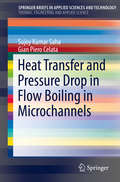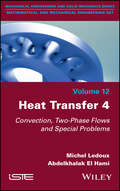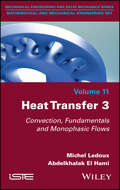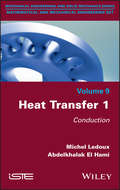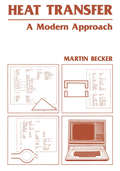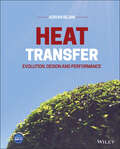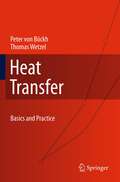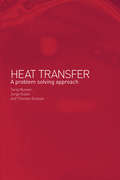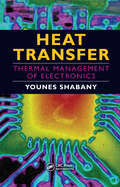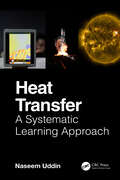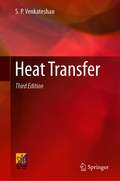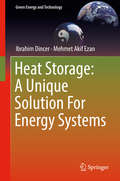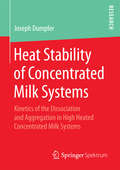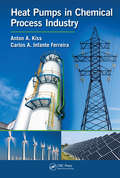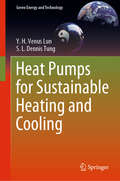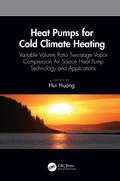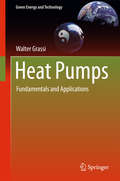- Table View
- List View
Heat Transfer and Pressure Drop in Flow Boiling in Microchannels (SpringerBriefs in Applied Sciences and Technology)
by Sujoy Kumar Saha Gian Piero CelataThis Brief addresses the phenomena of heat transfer and pressure drop in flow boiling in micro channels occurring in high heat flux electronic cooling. A companion edition in the Springer Brief Subseries on Thermal Engineering and Applied Science to “Critical Heat Flux in Flow Boiling in Micro channels,” by the same author team, this volume is idea for professionals, researchers and graduate students concerned with electronic cooling.
Heat Transfer 4: Convection, Two-Phase Flows and Special Problems
by Michel Ledoux Abdelkhalak El HamiHeat Transfer 4: Convection, Two-Phase Flows and Special Problems
by Michel Ledoux Abdelkhalak El HamiHeat Transfer 3: Convection, Fundamentals and Monophasic Flows
by Michel Ledoux Abdelkhalak El HamiHeat is a branch of thermodynamics that occupies a unique position due to its involvement in the field of practice. Being linked to the management, transport and exchange of energy in thermal form, it impacts all aspects of human life and activity. Heat transfers are, by nature, classified as conduction, convection (which inserts conduction into fluid mechanics) and radiation. The importance of these three transfer methods has resulted – justifiably – in a separate volume being afforded to each of them, with the subject of convection split into two volumes.This third volume is dedicated to convection, more specifically, the foundations of convective transfers. Various angles are considered to cover this topic, including empirical relationships and analytically approaching boundary layers, including the integral methods and numerical approaches. The problem of heat exchangers is presented, without aiming to be an exhaustive treatise. Heat Transfer 3 combines a basic approach with a deeper understanding of the discipline and will therefore appeal to a wide audience, from technician to engineer, from doctoral student to teacher-researcher.
Heat Transfer 3: Convection, Fundamentals and Monophasic Flows
by Michel Ledoux Abdelkhalak El HamiHeat is a branch of thermodynamics that occupies a unique position due to its involvement in the field of practice. Being linked to the management, transport and exchange of energy in thermal form, it impacts all aspects of human life and activity. Heat transfers are, by nature, classified as conduction, convection (which inserts conduction into fluid mechanics) and radiation. The importance of these three transfer methods has resulted – justifiably – in a separate volume being afforded to each of them, with the subject of convection split into two volumes.This third volume is dedicated to convection, more specifically, the foundations of convective transfers. Various angles are considered to cover this topic, including empirical relationships and analytically approaching boundary layers, including the integral methods and numerical approaches. The problem of heat exchangers is presented, without aiming to be an exhaustive treatise. Heat Transfer 3 combines a basic approach with a deeper understanding of the discipline and will therefore appeal to a wide audience, from technician to engineer, from doctoral student to teacher-researcher.
Heat Transfer 1: Conduction
by Michel Ledoux Abdelkhalak El HamiHeat is a branch of thermodynamics that occupies a unique position due to its involvement in the field of practice. Being linked to the management, transport and exchange of energy in thermal form, it impacts all aspects of human life and activity. Heat transfers are, by nature, classified as conduction, convection (which inserts conduction into fluid mechanics) and radiation. The importance of these three transfer methods has resulted – justifiably – in a separate volume being afforded to each of them. This first volume is dedicated to thermal conduction, and, importantly, assumes an analytical approach to the problems presented, and recalls the fundamentals. Heat Transfer 1 combines a basic approach with a deeper understanding of the discipline and will therefore appeal to a wide audience, from technician to engineer, from doctoral student to teacher-researcher.
Heat Transfer 1: Conduction
by Michel Ledoux Abdelkhalak El HamiHeat is a branch of thermodynamics that occupies a unique position due to its involvement in the field of practice. Being linked to the management, transport and exchange of energy in thermal form, it impacts all aspects of human life and activity. Heat transfers are, by nature, classified as conduction, convection (which inserts conduction into fluid mechanics) and radiation. The importance of these three transfer methods has resulted – justifiably – in a separate volume being afforded to each of them. This first volume is dedicated to thermal conduction, and, importantly, assumes an analytical approach to the problems presented, and recalls the fundamentals. Heat Transfer 1 combines a basic approach with a deeper understanding of the discipline and will therefore appeal to a wide audience, from technician to engineer, from doctoral student to teacher-researcher.
Heat Transfer: A Modern Approach
by M. BeckerThere have been significant changes in the academic environment and in the workplace related to computing. Further changes are likely to take place. At Rensselaer Polytechnic Institute, the manner in which the subject of heat transfer is presented is evolving so as to accommodate to and, indeed, to participate in, the changes. One obvious change has been the introduction of the electronic calcula tor. The typical engineering student can now evaluate logarithms, trigonomet ric functions, and hyperbolic functions accurately by pushing a button. Teaching techniques and text presentations designed to avoid evaluation of these functions or the need to look them up in tables with associated interpolation are no longer necessary. Similarly, students are increasingly proficient in the use of computers. At RPI, every engineering student takes two semesters of computing as a fresh man and is capable of applying the computer to problems he or she encoun ters. Every student is given personal time on the campus computer. In addition, students have access to personal computers. In some colleges, all engineering students are provided with personal computers, which can be applied to a variety of tasks.
Heat Transfer: Evolution, Design and Performance
by Adrian BejanHEAT TRANSFER Provides authoritative coverage of the fundamentals of heat transfer, written by one of the most cited authors in all of Engineering Heat Transfer presents the fundamentals of the generation, use, conversion, and exchange of heat between physical systems. A pioneer in establishing heat transfer as a pillar of the modern thermal sciences, Professor Adrian Bejan presents the fundamental concepts and problem-solving methods of the discipline, predicts the evolution of heat transfer configurations, the principles of thermodynamics, and more. Building upon his classic 1993 book Heat Transfer, the author maintains his straightforward scientific approach to teaching essential developments such as Fourier conduction, fins, boundary layer theory, duct flow, scale analysis, and the structure of turbulence. In this new volume, Bejan explores topics and research developments that have emerged during the past decade, including the designing of convective flow and heat and mass transfer, the crucial relationship between configuration and performance, and new populations of configurations such as tapered ducts, plates with multi-scale features, and dendritic fins. Heat Transfer: Evolution, Design and Performance: Covers thermodynamics principles and establishes performance and evolution as fundamental concepts in thermal sciences Demonstrates how principles of physics predict a future with economies of scale, multi-scale design, vascularization, and hierarchical distribution of many small features Explores new work on conduction architecture, convection with nanofluids, boiling and condensation on designed surfaces, and resonance of natural circulation in enclosures Includes numerous examples, problems with solutions, and access to a companion website Heat Transfer: Evolution, Design and Performance is essential reading for undergraduate and graduate students in mechanical and chemical engineering, and for all engineers, physicists, biologists, and earth scientists.
Heat Transfer: Evolution, Design and Performance
by Adrian BejanHEAT TRANSFER Provides authoritative coverage of the fundamentals of heat transfer, written by one of the most cited authors in all of Engineering Heat Transfer presents the fundamentals of the generation, use, conversion, and exchange of heat between physical systems. A pioneer in establishing heat transfer as a pillar of the modern thermal sciences, Professor Adrian Bejan presents the fundamental concepts and problem-solving methods of the discipline, predicts the evolution of heat transfer configurations, the principles of thermodynamics, and more. Building upon his classic 1993 book Heat Transfer, the author maintains his straightforward scientific approach to teaching essential developments such as Fourier conduction, fins, boundary layer theory, duct flow, scale analysis, and the structure of turbulence. In this new volume, Bejan explores topics and research developments that have emerged during the past decade, including the designing of convective flow and heat and mass transfer, the crucial relationship between configuration and performance, and new populations of configurations such as tapered ducts, plates with multi-scale features, and dendritic fins. Heat Transfer: Evolution, Design and Performance: Covers thermodynamics principles and establishes performance and evolution as fundamental concepts in thermal sciences Demonstrates how principles of physics predict a future with economies of scale, multi-scale design, vascularization, and hierarchical distribution of many small features Explores new work on conduction architecture, convection with nanofluids, boiling and condensation on designed surfaces, and resonance of natural circulation in enclosures Includes numerous examples, problems with solutions, and access to a companion website Heat Transfer: Evolution, Design and Performance is essential reading for undergraduate and graduate students in mechanical and chemical engineering, and for all engineers, physicists, biologists, and earth scientists.
Heat Transfer: Basics and Practice
by Peter Böckh Thomas WetzelThe book provides an easy way to understand the fundamentals of heat transfer. The reader will acquire the ability to design and analyze heat exchangers. Without extensive derivation of the fundamentals, the latest correlations for heat transfer coefficients and their application are discussed. The following topics are presented - Steady state and transient heat conduction - Free and forced convection - Finned surfaces - Condensation and boiling - Radiation - Heat exchanger design - Problem-solving After introducing the basic terminology, the reader is made familiar with the different mechanisms of heat transfer. Their practical application is demonstrated in examples, which are available in the Internet as MathCad files for further use. Tables of material properties and formulas for their use in programs are included in the appendix. This book will serve as a valuable resource for both students and engineers in the industry.The author’s experience indicates that students, after 40 lectures and exercises of 45 minutes based on this textbook, have proved capable of designing independently complex heat exchangers such as for cooling of rocket propulsion chambers, condensers and evaporators for heat pumps.
Heat Transfer: A Problem Solving Approach
by Tariq Muneer Kubie Jorge Grassie ThomasA core task of engineers is to analyse energy related problems. The analytical treatment is usually based on principles of thermodynamics, fluid mechanics and heat transfer, but is increasingly being handled computationally.This unique resource presents a practical textbook, written for both undergraduates and professionals, with a series of over 60 computer workbooks on an accompanying CD.The book emphasizes how complex problems can be deconstructed into a series of simple steps. All thermophysical property computations are illustrated using diagrams within text and on the companion CD.
Heat Transfer: A Problem Solving Approach
by Tariq Muneer Kubie Jorge Grassie ThomasA core task of engineers is to analyse energy related problems. The analytical treatment is usually based on principles of thermodynamics, fluid mechanics and heat transfer, but is increasingly being handled computationally.This unique resource presents a practical textbook, written for both undergraduates and professionals, with a series of over 60 computer workbooks on an accompanying CD.The book emphasizes how complex problems can be deconstructed into a series of simple steps. All thermophysical property computations are illustrated using diagrams within text and on the companion CD.
Heat Transfer: Thermal Management of Electronics
by Younes ShabanyThe continuing trend toward miniaturization and high power density electronics results in a growing interdependency between different fields of engineering. In particular, thermal management has become essential to the design and manufacturing of most electronic systems.Heat Transfer: Thermal Management of Electronics details how engineers can use
Heat Transfer: A Systematic Learning Approach
by Naseem UddinHeat Transfer: A Systematic Learning Approach presents valuable tools for understanding heat transfer mechanisms and provides a clear understanding of complex turbulent flows. It gives a comprehensive introduction to topics of heat transfer, including conduction, convection, thermal radiation, and nanofluids.Covering both traditional analytical models for canonical flows and modern turbulence modeling approaches for heat transfer, the book discusses complex impinging jet flow, phase change flows, nanofluids, and convective mass transfer flow. The text includes numerous end-of-chapter problems to enhance student understanding and different solving approaches. It offers the basic flow and energy analysis along with useful MAPLE code to facilitate the learning process.The book is intended for senior undergraduate mechanical, aerospace, and chemical engineering students taking courses in heat transfer.Instructors will be able to utilize a Solutions Manual, Jupyter Notebook programmes, and Figure Slides for their courses.
Heat Transfer: A Systematic Learning Approach
by Naseem UddinHeat Transfer: A Systematic Learning Approach presents valuable tools for understanding heat transfer mechanisms and provides a clear understanding of complex turbulent flows. It gives a comprehensive introduction to topics of heat transfer, including conduction, convection, thermal radiation, and nanofluids.Covering both traditional analytical models for canonical flows and modern turbulence modeling approaches for heat transfer, the book discusses complex impinging jet flow, phase change flows, nanofluids, and convective mass transfer flow. The text includes numerous end-of-chapter problems to enhance student understanding and different solving approaches. It offers the basic flow and energy analysis along with useful MAPLE code to facilitate the learning process.The book is intended for senior undergraduate mechanical, aerospace, and chemical engineering students taking courses in heat transfer.Instructors will be able to utilize a Solutions Manual, Jupyter Notebook programmes, and Figure Slides for their courses.
Heat Transfer
by S.P. VenkateshanThe book covers various topics of heat transfer. It explains and analyzes several techniques and modes of heat transfer such as conduction in stationary media, convection in moving media and also by radiation. It is primarily a text book useful for undergraduate and postgraduate students. The book should also interest practicing engineers who wish to refresh their knowledge in the field. The book presents the various topics in a systematic way starting from first principles. The topics are developed to a fairly advanced level towards the end of each chapter. Several worked examples illustrate the engineering applications of the basic modeling tools developed in the text. The exercises at the end of the book are arranged chapter wise and challenge the reader to tackle typical real-life problems in heat transfer. This book will be of potential use for students of mechanical engineering, chemical engineering and metallurgy in most engineering colleges.
Heat Storage: A Unique Solution For Energy Systems (Green Energy and Technology)
by Ibrahim Dincer Mehmet Akif EzanThis book covers emerging energy storage technologies and material characterization methods along with various systems and applications in building, power generation systems and thermal management. The authors present options available for reducing the net energy consumption for heating/cooling, improving the thermal properties of the phase change materials and optimization methods for heat storage embedded multi-generation systems. An in-depth discussion on the natural convection-driven phase change is included. The book also discusses main energy storage options for thermal management practices in photovoltaics and phase change material applications that aim passive thermal control. This book will appeal to researchers and professionals in the fields of mechanical engineering, chemical engineering, electrical engineering, renewable energy, and thermodynamics. It can also be used as an ancillary text in upper-level undergraduate courses and graduate courses in these fields.
Heat Stability of Concentrated Milk Systems: Kinetics of the Dissociation and Aggregation in High Heated Concentrated Milk Systems
by Joseph DumplerIn his study, Joseph Dumpler proves a strong correlation between the dry matter content of the milk concentrate and the maximum temperature-time combinations for the heat treatment of concentrated skim milk without visible coagulation. The author also states that direct heat treatment is superior to indirect heat treatment for preservation of liquid milk concentrates or decontamination of concentrated milk before spray drying.
Heat Pumps in Chemical Process Industry
by Anton A. Kiss Carlos A. Infante FerreiraAs the chemical process industry is among the most energy demanding sectors, chemical engineers are endeavoring to contribute towards sustainable future. Due to the limitation of fossil fuels, the need for energy independence, as well as the environmental problem of the greenhouse gas effect, there is a large increasing interest in the research and development of chemical processes that require less capital investment and reduced operating costs and lead to high eco-efficiency. The use of heat pumps is a hot topic due to many advantages, such as low energy requirements as well as an increasing number of industrial applications. Therefore, in the current book, authors are focusing on use of heat pumps in the chemical industry, providing an overview of heat pump technology as applied in the chemical process industry, covering both theoretical and practical aspects: working principle, applied thermodynamics, theoretical background, numerical examples and case studies, as well as practical applications. The worked-out examples have been included to instruct students, engineers and process designers about how to design various heat pumps used in the industry. Reader friendly resources namely relevant equations, diagrams, figures and references that reflect the current and upcoming heat pump technologies, will be of great help to all readers from the chemical and petrochemical industry, biorefineries and other related areas.
Heat Pumps in Chemical Process Industry
by Anton A. Kiss Carlos A. Infante FerreiraAs the chemical process industry is among the most energy demanding sectors, chemical engineers are endeavoring to contribute towards sustainable future. Due to the limitation of fossil fuels, the need for energy independence, as well as the environmental problem of the greenhouse gas effect, there is a large increasing interest in the research and development of chemical processes that require less capital investment and reduced operating costs and lead to high eco-efficiency. The use of heat pumps is a hot topic due to many advantages, such as low energy requirements as well as an increasing number of industrial applications. Therefore, in the current book, authors are focusing on use of heat pumps in the chemical industry, providing an overview of heat pump technology as applied in the chemical process industry, covering both theoretical and practical aspects: working principle, applied thermodynamics, theoretical background, numerical examples and case studies, as well as practical applications. The worked-out examples have been included to instruct students, engineers and process designers about how to design various heat pumps used in the industry. Reader friendly resources namely relevant equations, diagrams, figures and references that reflect the current and upcoming heat pump technologies, will be of great help to all readers from the chemical and petrochemical industry, biorefineries and other related areas.
Heat Pumps for Sustainable Heating and Cooling (Green Energy and Technology)
by Y. H. Lun S. L. TungThis book highlights the significance of using sustainable energy to prevent the deterioration of our planet using heat pumps. Energy sustainability can be achieved through improved energy efficiency. In this regard, heat pumps offer an energy-efficient alternative for heating and cooling. To drive the adoption of heat pumps as a key component of sustainable buildings, the authors focus on examining sustainable practices in heat pump operations and innovative system design. In view of the growing desire to use sustainable energy to meet heating and cooling demands and improve indoor air quality, this book offers a valuable reference guide to the available options in HVAC (heating, ventilation, and air-conditioning) system design. To begin with, the authors define sustainable energy and discuss the trend of “thinking green” in building design. They then discuss sustainable practices and heat pump applications in mapping out HVAC systems. In turn, they examine the use of green operations to promote sustainable practices and, in order to highlight the importance of innovative design, discuss the configuration options and precision control aspects. In closing, the authors illustrate innovative sustainable design on the basis of several energy-efficient cases. The book’s main goal is to drive the adoption of sustainable energy solutions. Heat pumps, it argues, represent the most efficient system for meeting commercial/recreational/residential heating and cooling demands. The book not only examines industrial practices in heat pump application, but also discusses advanced heat pump technologies and innovative heat pump designs.
Heat Pumps for Cold Climate Heating: Variable Volume Ratio Two-stage Vapor Compression Air Source Heat Pump Technology and Applications
by Hui HuangAir source heat pumps are mainly used for space heating, and have the advantages of environmental protection, energy saving, and comfort. Written by leading heat pump technology expert Hui Huang, this book summarizes the research and applications of variable volume ratio two-stage vapor compression air source heat pump technology, and its use in cold climate regions. This book can be used for reference by scientific researchers and engineers engaged in research on air source heat pump technology, product development and popularization; and by energy management and policy researchers. It will also be of value to undergraduate and graduate students studying these areas of technology.
Heat Pumps for Cold Climate Heating: Variable Volume Ratio Two-stage Vapor Compression Air Source Heat Pump Technology and Applications
by Hui HuangAir source heat pumps are mainly used for space heating, and have the advantages of environmental protection, energy saving, and comfort. Written by leading heat pump technology expert Hui Huang, this book summarizes the research and applications of variable volume ratio two-stage vapor compression air source heat pump technology, and its use in cold climate regions. This book can be used for reference by scientific researchers and engineers engaged in research on air source heat pump technology, product development and popularization; and by energy management and policy researchers. It will also be of value to undergraduate and graduate students studying these areas of technology.
Heat Pumps: Fundamentals and Applications (Green Energy and Technology)
by Walter GrassiThe text describes the main features of currently available heat pumps, focusing on system operation and interactions with external heat sources. In fact, before choosing a heat pump, several aspects must be assessed in detail: the actual climate of the installation site, the building’s energy requirements, the heating system, the type of operation etc. After discussing the general working principles, the book describes the main components of compression machines – for EHPs, GHPs and CO2 heat pumps. It then addresses absorption heat pumps and provides additional details on the behavior of two-fluid mixtures. The book presents a performance comparison for the different types, helping designers choose the right one for their needs, and discusses the main refrigerants. Notes on helpful additional literature, websites and videos, also concerning relevant European regulations, round out the coverage. This book will be of interest to all engineers and technicians whose work involves heat pumps. It will also benefit students in energy engineering degree programs who want to deepen their understanding of heat pumps.
